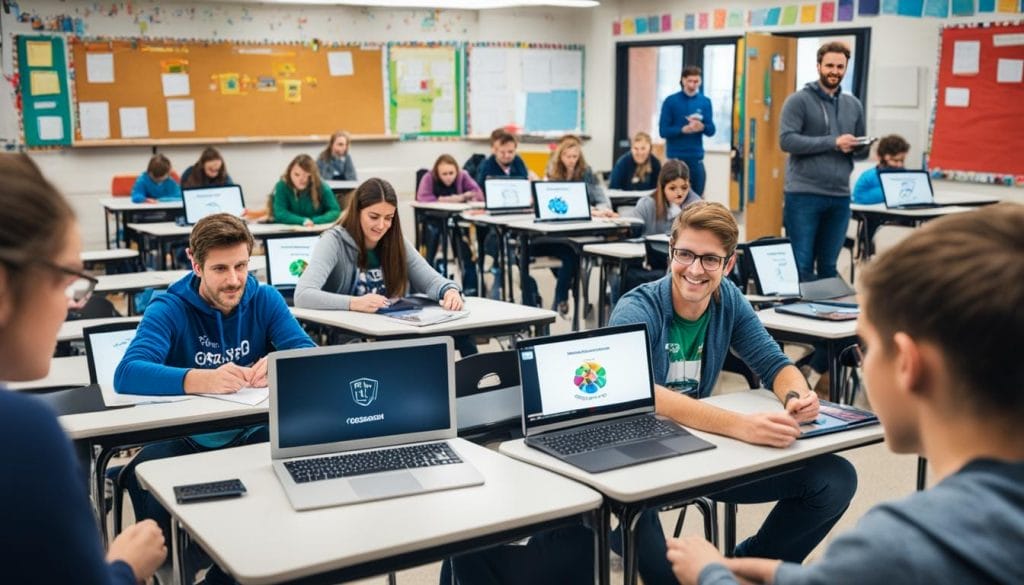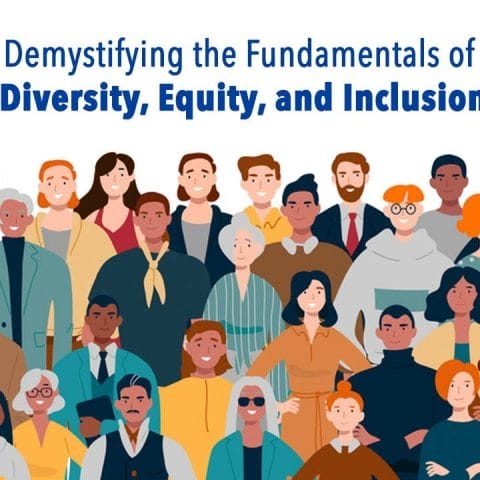Did you know that nearly 70% of colleges in the U.S. are now using blended learning? This shows how big of a role hybrid learning is playing in changing education. By mixing traditional classes with online tools, blended learning makes learning more flexible and fun. Companies like Hyperspace are leading this change, offering tools that help teachers get students more involved in their learning.
Key Takeaways
- Blended learning combines traditional instruction with digital technologies for improved outcomes.
- Nearly 70% of U.S. higher education institutions are utilizing blended learning models.
- Hybrid learning promotes greater flexibility and accessibility for diverse learners.
- Educational technology plays a crucial role in engaging students and enhancing their learning experience.
- Companies like Hyperspace provide essential tools for implementing effective blended learning practices.
Understanding Blended Learning
Blended learning is a new way to teach that mixes different ways of learning. It combines online and traditional classes to make learning flexible. Knowing what blended learning is helps teachers improve how they teach.
Definition and Key Components
At its heart, blended learning blends online and in-person learning. It uses a mix of formats to offer various teaching methods. This approach helps students stay engaged and learn on their own, making school open to everyone.
Types of Blended Learning Models
There are many blended learning models out there, each suited for different schools. Some top models are:
- Flipped Classroom: Students learn new stuff online, then do activities in class.
- Rotation Model: Students switch between online and in-person classes.
- Flex Model: Most learning happens online, with teachers helping when needed.
Studies show blended learning can boost grades and change how students feel about school. But, its effects can differ in places like the USA and China, especially in how much students get involved.
Benefits of Blended Learning
Blended learning brings many benefits to education. It mixes old teaching ways with new tech. This creates a space that supports flexibility in education and accessibility in blended learning.
Flexibility and Accessibility
This way of learning gives students the freedom to choose their learning paths. It lets them look at materials and join discussions when it fits their schedule. This makes learning available to more people, no matter their personal life or how they like to learn.
Diverse Learning Methods
Blended learning also offers a mix of different ways to learn. This meets the needs of various learners, making classes more engaging and clear. Students get to use pictures, online tools, and traditional lectures together. Teachers can then tailor learning to each student’s needs better.
Enhanced Learning Outcomes with Blended Learning
Blended learning greatly improves enhanced academic performance for students. It mixes traditional classroom teaching with online parts. This way, students often do better than with just old-school methods.
This method creates a lively setting where students dive deeper into the material. They get to understand it better.
One big plus of blended learning is how it mixes in-person classes with digital tools. Students can learn at their own speed. Studies show this mix boosts blended learning outcomes, especially in subjects like health education.
In nursing programs, blended learning leads to better problem-solving skills and keeping knowledge over time.
With these new teaching methods, students get more chances to shine. They can work together on projects or join online chats. This mix of methods makes learning full and leads to top-notch grades.
The Role of Educational Technology
Educational technology is key to making blended learning work better. It helps teachers use digital tools to keep students engaged and retain more knowledge. These tools make learning fun and allow teachers to give lessons that fit each student’s needs.
Integrating Digital Tools
Digital tools are vital for a great blended learning experience. Tools like Google Classroom, Canvas, and Edmodo help teachers manage courses, share resources, and talk to students easily. These tools create a more interactive classroom where students can work together and share ideas.
Creating Virtual Classrooms
Virtual classrooms let teachers teach students from anywhere. They use digital platforms for live talks, presentations, and group work. This makes learning exciting and brings together students from different places.
| Digital Tool | Features | Benefits |
|---|---|---|
| Google Classroom | Assignment management, real-time feedback | Streamlined learning, enhanced collaboration |
| Zoom | Video conferencing, breakout rooms | Interactive discussions, peer engagement |
| Edmodo | Social learning network, resource sharing | Community building, peer support |
| Canvas | Course management, customizable content | Personalized learning, adaptive resources |
Using these digital tools and virtual classrooms makes learning better for everyone. It helps teachers and students do their best.
Effective Assessment in Blended Learning
Assessing blended learning needs a smart plan. It must use different ways to check how well students are doing. It’s important to see how students do in both online and in-person parts.
Performance Metrics
Using many performance metrics helps teachers get a full picture of how students are doing. These metrics include:
- Test scores and grades
- Assignment completion rates
- Participation in discussions and activities
- Feedback from peers and instructors
This way, teachers can see how students are doing overall. They can then change their teaching to meet the students’ needs better.
Utilizing Learning Analytics
Learning analytics are key in checking blended learning. They help teachers see how students are doing and what they need to work on. The main benefits are:
- Personalized learning experiences
- Informed decision-making on teaching methods
- Feedback for students in real time
By using learning analytics, schools can make learning fit each student better. This leads to more success in school.
Improving Student Engagement

Getting students involved is key in blended learning. Using interactive ways to learn boosts their participation and makes learning fun. By offering different interactive chances, teachers can make the classroom more exciting and connect with students deeply.
Interactive Learning Opportunities
Interactive learning changes the way we teach, making it more lively. Some ways to do this include:
- Group projects that encourage working together.
- Virtual discussions for quick chats.
- Hands-on activities that link theory to real life.
These methods do more than just get students involved in blended learning. They also make the material more relevant to their everyday lives. Technology adds to the interactive experience, giving students a space to grow.
Motivating Students Through Personalized Instruction
Personalized teaching is key to keeping students motivated. By making learning fit each student’s needs, teachers can boost engagement. Important steps include:
- Knowing how each student learns best.
- Using different ways to share content for all abilities.
- Setting goals that match each student’s interests.
When students see that their unique strengths and likes are valued, they’re more likely to take part. This leads to better results and keeps them interested in learning.
| Interactive Learning Method | Benefits |
|---|---|
| Group Projects | Fosters teamwork and collaboration. |
| Virtual Discussions | Enhances communication skills. |
| Hands-On Activities | Encourages practical application of knowledge. |
| Personalized Learning | Increases motivation through tailored experiences. |
Synchronous and Asynchronous Learning Approaches
Synchronous and asynchronous learning are key parts of today’s education. Knowing the difference between them is important for teachers. Each style has its own way of teaching, fitting different students’ needs. They work well together to improve learning.
Defining Synchronous Learning
Synchronous learning means everyone learns at the same time. Students and teachers talk together, creating a team feeling. This way, students get feedback right away and feel connected to each other.
Classrooms are a classic example of this, where talks happen face-to-face or online.
Advantages of Asynchronous Learning
Asynchronous learning is great for those who like to learn at their own pace. Students can look at materials, do tasks, and talk with others whenever they want. This makes learning fit everyone’s life better.
Students can go back to lectures, try out interactive stuff, and think about what they learned without feeling rushed. Mixing both types of learning lets schools offer a full and flexible way to learn that suits everyone.
| Learning Type | Key Features | Best Use Cases |
|---|---|---|
| Synchronous Learning | Real-time interaction, immediate feedback, structured schedule | Live classes, webinars, team projects |
| Asynchronous Learning | Flexible schedule, self-paced, on-demand resources | Online courses, recorded lectures, discussion forums |
Using both kinds of learning gives students a well-rounded education. It keeps them interested and meets their unique needs. For more on how technology changes education, check out the educational game design article.
Implementing Blended Learning Strategies

Blended learning needs new ways to design and carry out. It mixes traditional teaching with online tools for a better learning experience. Teachers can make learning fun and effective by using different ways to share content.
Designing a Hybrid Curriculum
Building a hybrid curriculum means picking parts that work well together. It’s important to mix online and in-person learning so they support each other. To do this, teachers must know what students need, set clear goals, and choose the right tools.
Tips for Instructors
Teachers can make blended learning work better by using technology to talk and give feedback easily. Encouraging students to work together helps them learn from each other. Checking how well the lessons work helps improve them and keep them up-to-date.
For more tips on making blended learning work, check out this guide to blended learning implementation.
Overcoming Challenges in Blended Learning
Blended learning brings its own set of challenges, especially with technology and keeping students engaged. To overcome these, we need a strong plan. This plan should improve the learning environment and support both students and teachers.
Addressing Technological Limitations
Getting past technology hurdles is key to blended learning success. Schools must invest in reliable tech to make sure every student can use it. Working with government programs or local businesses can help get the needed resources.
As technology changes, keeping up with new tools is crucial. This helps create a better learning space for everyone.
Engaging Students in a Hybrid Environment
Keeping students interested and motivated is vital in both online and in-person classes. Using interactive discussions, multimedia, and group work can make learning more engaging. Teachers need ongoing training to use these methods well.
There are creative ways to tackle the challenges of blended learning. Learning from pilot projects and talking with different groups can lead to great strategies. These strategies work well for both students and teachers. For more on how to overcome these challenges, check out this link.
Conclusion
Blended learning combines traditional teaching with new digital tools. This mix makes learning flexible and engaging for students. It helps students do better and feel more satisfied with their education.
The future of blended learning looks bright, thanks to new tech in education. Schools that adapt can use the latest tools to improve learning. This change is a big step forward in how we teach and learn.
Groups like Hyperspace are helping educators and schools use blended learning well. By focusing on blended learning, schools can give students rich learning experiences. This way, every student can succeed in today’s fast-paced world.
FAQ
What is blended learning?
Blended learning mixes traditional classroom teaching with online learning. It aims to make learning flexible and engaging. This approach improves learning outcomes.
What are the benefits of blended learning?
Blended learning boosts student interest and makes learning available to more people. It also leads to better grades and tailors instruction to each student’s way of learning.
How does educational technology support blended learning?
Tech tools like Learning Management Systems (LMS) and chat platforms help blended learning. They create online classrooms and extend learning outside the classroom.
What types of blended learning models exist?
There are several models, like the flipped classroom, rotation model, and flex model. Each combines online and in-person teaching to improve learning.
How can instructors boost student engagement in a blended learning setting?
Teachers can make learning fun with group projects, online chats, and lessons that match what students like and need.
What challenges might arise when implementing blended learning?
Issues can include tech problems, students not staying interested, and making sure the curriculum works well online and in class.
What is the difference between synchronous and asynchronous learning in blended environments?
Synchronous learning means students and teachers work together in real time. Asynchronous learning lets students learn at their own speed.
How is student performance assessed in blended learning?
Assessing students in blended learning uses many ways, including learning analytics. These tools track student progress and help teachers tailor lessons.
Can blended learning improve academic performance?
Yes, studies show blended learning can lead to better grades, especially in subjects like health education.
What are practical tips for educators implementing blended learning?
Teachers should plan a well-rounded curriculum with various ways to share information. Use tech for talking and giving feedback. Encourage students to work together to boost interaction.





